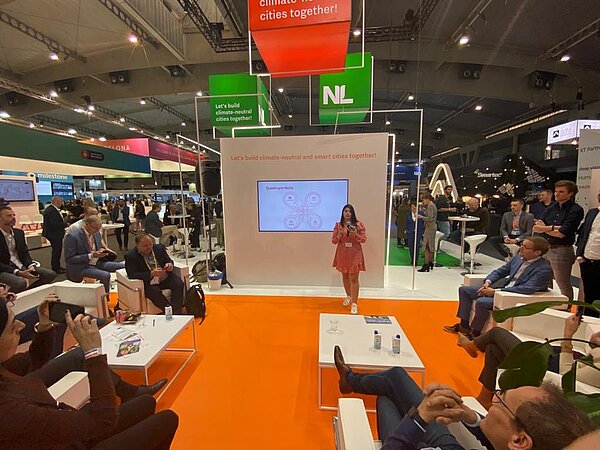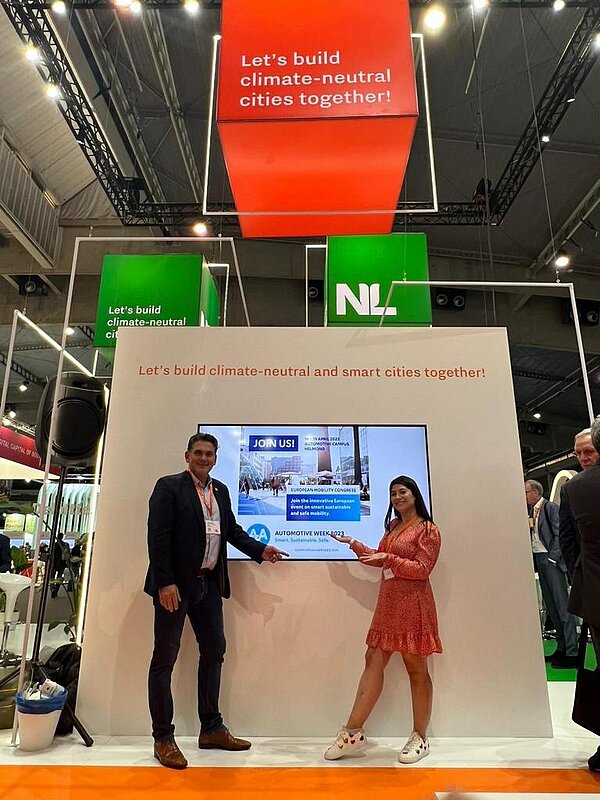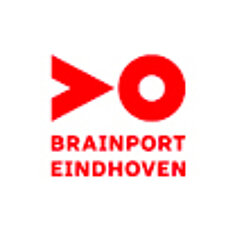Brainport on the road to sustainable and smart mobility

Brainport's mobility team has been organizing and coordinating the smart and green mobility contribution on behalf of all Dutch parties since its first participation in SCEWC. This includes pitch sessions and matchmaking opportunities during the expo, networking events and workshops and substantive contributions to the international business forum organized by the Netherlands together with the Nordics.
One of the presentations at the Smart City Expo World Congress in Barcelona was about the Quadruple Helix. Ana Alanis is project leader Smart Mobility at Brainport Development in Eindhoven and explained why this new approach is so important for a successful roll-out of sustainable mobility in smart cities. We are of course curious to hear her story.
You are originally from Mexico, how did you come to work at Brainport Eindhoven?
The Brainport Eindhoven region is known for its high-tech industry and good cooperation between companies, research institutions and governments. Moreover, Brainport is known for its Mobility Agenda and years of working on sustainable and smart mobility.
As an engineer and urban planner focused on sustainable mobility, Brainport Eindhoven is a perfect region where I can share my knowledge, help large, medium and small companies accelerate and implement smart and sustainable mobility and at the same time have an economic and social impact locally and nationally.
Our ultimate goal: zero emissions, zero traffic jams and zero traffic fatalities.
What is Brainport doing and what is your part in it?
Brainport has an agenda consisting of three pillars: innovation, technology and entrepreneurship; talent: the fuel for our technological engine; and living environment and business climate.
The mobility team is part of the larger tech-market team. The tech-market team focuses on the first pillar by developing key technologies of the future, and by combining new technology-market for societal challenges.
Our ultimate goal: zero emissions, zero congestion and zero traffic fatalities. This requires not only smart technology solutions, but a transition of an entire infrastructure and industry. There is a widespread need for sustainable, emission-free, smart and safe technological mobility solutions.
Moreover, we support SMEs, start-ups and scale-ups by establishing collaborations and projects with research institutions and large companies.

Your topic is Mobility Challenges from a Quadruple Helix perspective, we are used to working with the triple Helix, Which is the fourth and what is its importance?
The fourth aspect is society. Society will be key when it comes to innovation. We are in a transition of eras, mobility, energy and social. To achieve such transitions we need both technological and societal innovations.
In the case of mobility, this combination can be found in shared mobility. Shared mobility is not just about platforms and mobility as a service, but about the practices behind it. Through shared mobility we create new ideas and social norms, and at the same time we create service-dominated business models. Therefore, we can see the quadruple helix as stakeholders working together on new ways of thinking, doing and organizing.
How can technology help engage society in accelerating sustainable transitions?
Technology can help society understand the consequences of their decisions in a simpler way. A clear example is digital twinning; with these tools, governments can plan citizen participation workshops where they can show in a visual way what it means for them, their families and their neighbors to travel by car, bike, public transport or shared mobility in terms of space, greenery and livability of their environment.
What kind of thinking and action do we need to make that transition successful?
As a society, we need to understand that we need to make a small sacrifice for the good of the planet. We need to think about future generations and the kind of world we want to leave them, and the problems we can avoid if we act now.
Can you give examples in the area of mobility that are important in this sustainable transition?
Examples of how social behavior and technology can be combined in the field of mobility are: Mobility as a Service (MaaS): use of services from apps, the service is chosen by the user based on their commuting needs.
1. Shared mobility: provide a good option to car ownership.
2. Public transportation: related to service, modal shift, transportation-oriented development.
3. Working from home: the possibility of not commuting at all
4. Autonomous driving: services on demand (public transport), efficient and reliable
5. Electric driving: emission-free vehicles
How do you see the development of smart cities, what is the urgency and what is needed to accelerate the development?
For me, a smart city is not just a city that is technologically modern and collects data, but it is that city that knows how to use the collected data to make data-driven decisions. It is a city that works well with its research institutions, businesses and citizens.
An ecosystem of different stakeholders is what is needed to accelerate the adoption of smart cities.

"The Digital Infrastructure for Future-proof Mobility (DITM) project enables the Netherlands to organize mobility more efficiently and safely on a national level, create a stronger export position internationally for Dutch technology and influence international standards."
Brainport Eindhoven is active in the themes of Energy, Health, Nutrition and Mobility, among others. In the latter area, Alanis is intensively involved. The ambition here is triple zero: zero emissions, zero traffic jams and zero traffic fatalities. This requires not only smart technological solutions, but a transition of an entire infrastructure and industry. It is the partnerships within an innovative ecosystem that will further strengthen Brainport Eindhoven's strong global position as a cradle of smart and sustainable mobility.... Brainport has an excellent position with its many partners, the closely cooperating, innovative companies, IT companies and knowledge and educational institutions with mobility as a strategic spearhead. Add to that the Automotive sector, Automotive Campus and government.
A large-scale project is currently underway; Digital Infrastructure for Future-proof Mobility (DITM), made possible in part by the Ministry of Infrastructure and Water Management.
Led by Brainport Development, the project partners are working concretely to develop:
1. Autonomous functions related to connectivity, localization, and navigation of different vehicle platforms (bus, passenger car) in different use cases: a.o. yard maneuvering, lane-navigation, automatic approach and stopping of bus stops and platooning (driver: VDL ETS).
2. An 'energy exchange system' (EnergyPod) as a crucial link between the autonomous electric vehicle (EV) and the electricity grid and which offers energy in a cyber secure and reliable way to the grid operators (driver: Heliox).
3. An innovative map production system that produces and updates maps based on continuous sensor observations of the road infrastructure and the increasing number of 'smart' vehicles on the road. This compared to the use of a current fleet of Mobile Mapping vehicles which are insufficiently scalable and up-to-date to enable autonomous driving. (Tractor: TomTom).
4. A Validation Lab consisting of a virtual simulation and a physical test environment (including test road A270, Fabulos route and intelligent intersections). This to validate both technology development and macro-scale simulations for improved substantiation of (future) system choices around mobility design issues and investment decisions (initiator: TNO).
